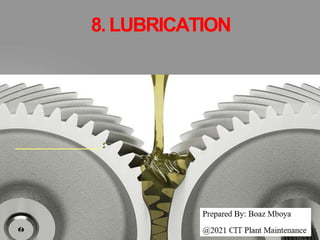This document discusses lubrication and lubricants. It begins by explaining the purposes of lubrication which are to reduce friction and wear, transfer heat, clean parts, provide protection, seal parts, and transmit power. It then discusses the principles of lubrication including hydrodynamic, elastohydrodynamic, boundary, and hydrostatic lubrication. The document categorizes lubricants as solid, semi-solid, liquid, and gaseous. Key properties of lubricants that are described include kinematic viscosity, viscosity index, pour point, flash point, and total base number. The document provides examples of how to select lubricants based on factors like temperature, speed, load, and operating conditions. It also discusses lubrication systems
































































































